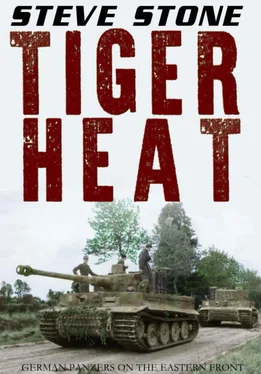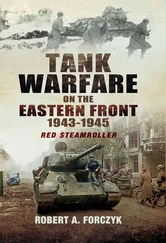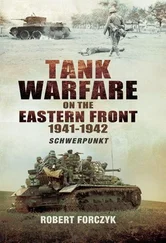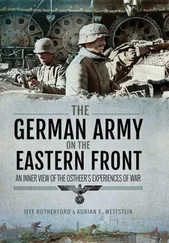A major part of being a tanker was that of tank maintenance and having enough fuel and ammunition. Sometimes this would mean scavenging fuel and ammunition from disabled tanks or even enemy vehicles if they used the same fuel. Fuel became a much scarcer resource as the war in Russia went into its final year. Maintenance was of great importance if a tank was to be given its best chance of survival. The heavier the tank the more strain it put on its mechanicals. Tanks have a track system that consists of the actual tracks, road wheels and a suspension system. On a heavy tank like the Tiger, parts wear out quickly especially if the correct maintenance is not carried out. Road wheels suffer blows with tree stumps, boulders and battlefield wreckage and can easily be damaged. The individual track elements are held together with long pins that need constant attention and can easily fail. These need to be looked at almost continuously to the point that they are routinely checked whenever the tank comes to a stop when not in combat, whatever the weather. If these pins fail, the tank will throw a track and the tank becomes immobilized. The track links themselves each weighed about ten kilos. They wear quickly especially when off road and the tracks must be tightened and adjusted so the track does not break become tangled on the drive wheel sprocket. The pins that hold these links together are thick steel rods and weigh about 1-2Kg each. These heavy and very strong pins eventually bend under the massive strain of propelling the very heavy Tiger forward. Even more so on difficult terrain. The link pins on all the Tigers were looking distorted and loose.
Spot tightening of road wheels and pins aids their longevity. Friction causes the most issues, as cause’s parts to wear much quicker. This means greasing wheel hubs and suspension parts. After a river crossing or operating in very wet conditions this becomes even more essential as the grease can become washed out leading to hubs overheating and seizing. A Russian T-34 tank can use 1Kg of grease for every 60 miles it covers on a dry surface. Engines, gearboxes and transmission all lose a small amount of oil when in use and again need to be topped up. Gaskets especially those made of rubber become brittle in the intense cold of Russia. When these fail, oil losses can be massive and seize an engine or transmission. A weekly engine and transmission check for wear was undertaken by checking the engine compartment for metal shavings, which could indicate excessive wear. Batteries needed to be checked and topped up if necessary.
Turret systems including hydraulic reservoirs, optics and radios needed to be checked as well and the main gun needed to be bore-sighted again after any significant move or firing. If the optical telescope and main gun went out of alignment either through battle damage or extreme terrain this could put the main gun out of alignment causing it to lose accuracy and making the gunner’s job of hitting a target very difficult.
Good maintenance helped prevent breakdowns and field repairs. Some such as replacing a broken torsion bar were difficult to perform in the field. With the need to remove road wheels and judicious use of a sledgehammer to remove the broken torsion bar. If not replaced and continued to be driven on the weight would have to be taken by the other torsion bars, which would quickly fail as well. In the field, this sort of job could take four to six hours. Often tanks were pushed to operate even when not fully operational just to play the numbers game.
For a tank battalion, efficient recovery and fuelling faculties in the field were essential.
The biggest issue for the Tiger on the Eastern Front during the winter months when mud and snow would pack into the tracks and freeze up. This caused the tracks to jam and the tank to be effectively immobilized. When the Red Army realised this, they timed their attacks for the early morning before the snow/mud could thaw out. Another issue in leaving tanks to get too cold was that the ionised water inside the tank’s batteries froze, cracking the cases, which required immediate replacement – but batteries were in short supply. Even without the batteries rupturing the intense cold caused the batteries to struggle to hold enough charge to turn the tanks engine over. Even if the batteries didn’t rupture, the charge they could hold dropped off rapidly below freezing. Even when the Germans managed to start their tanks, they found that the cold weather had a serious adverse effect on electrical and more sensitive equipment. Radios seemed to hate the cold and condensation which turned to ice often made them inoperable. The gunner’s sight was also prone to having condensation freeze either fully or partially blocking the view. As the optics tended to trap frost inside the lenses. Tank maintenance also became very difficult in temperatures below –29°C. Any exposed skin would instantly freeze to metal surfaces and even standard oil lubricants and tank grease became too thick to be able to use. Lubrication was key to stopping excessive wear of the running gear. Tasks like changing a torsion bar or drive sprocket proved to be impossible without proper shelter in very low sub-zero temperatures.
Rubber coatings on power cables could also crack at temperatures below –29°C. Petrol and diesel fuels were also affected by severe cold, which could have ice crystals form in fuel lines. Below –32°C, the hydraulic fluid in the main gun’s recoil system would freeze, resulting in the main gun being badly damaged if fired. The lubricant in machine-guns froze at –37°C, making the weapons unusable until cleaned. Ammunition became difficult to work with after being frozen and the main gun breech could become very ‘sticky’ after a frost, resulting in rounds becoming stuck in the breach.
Starting an engine that had been idle for several days in sub-zero temperatures proved very difficult for the Germans and they resorted to extreme measures, such as building a wood fire under the tank. Once heated, the frost turned to condensation inside equipment, which could cause electrical issues. In contrast, the Soviet T-34 had been designed and tested to work in the harsh Russian winters. It had internal compressed air bottles for cold weather starting. The T-34 had better crew heating and a design that took into account issues of very low temperatures.
This again made German panzer units became vulnerable if attacked by Soviet armour early in the day, when many panzers could not start. If the tanks could not be started and the Germans had to withdraw, the Germans had no choice but to abandon their tanks.
Another issue was the sheer size and weight of the Tiger. Only a handful of bridges were strong enough to cope with the weight of the Tiger, which increased with the Tiger II. To counter this issue, the first 495 Tigers were fitted with a snorkel, which allowed them to cross-rivers up to a depth of 13 feet. However, this was abandoned as an economy measure. This meant later versions could only operate to a depth of 4 feet. To stop water entering via the turret ring an inflatable rubber tube was inserted. This would be inflated prior to entering any water and provided a watertight seal for the turret ring.
CHAPTER TWO – Bridge to Nowhere
Once the Tigers had burst out from the forest and were back out in the open the bodies of fallen soldiers were still everywhere. There had been an intense firefight here. The ground was full of holes from where artillery shells had exploded and you could even see bits of frozen human remains hanging in the trees. The one that took the crews aback was a head. Initially, they thought it was a sniper, its pale head looking towards the tank crews. The crews let of a couple of volleys of fire from their MP 40s. However, soon realized it was a dismembered head that had be blown up into the branches of the trees. The forces involved with heavier weapons and what they could do to the human body could be seen all too clearly on the battlefield. Bodies ripped apart from the intense forces and in some cases charred from the intense heat. It showed all too clearly how frail the human body was and the intense violence of war.
Читать дальше












